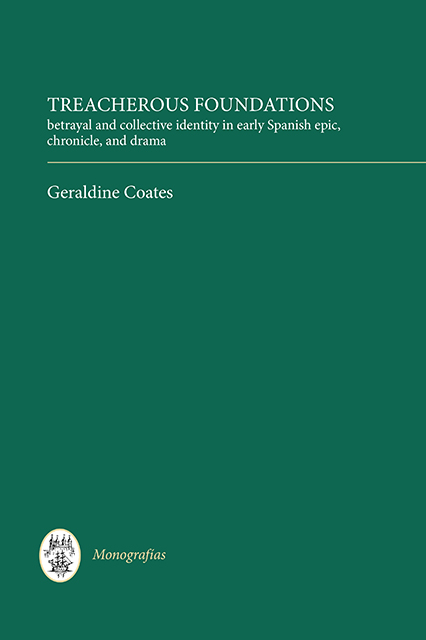 Treacherous Foundations
Treacherous Foundations Book contents
- Frontmatter
- Contents
- Dedication
- Acknowledgements
- Abbreviations
- 1 Introduction
- 2 Trauma and Triumph in the Poema de Fernán González
- 3 ‘Et si desto menguas’: Imperial Decline in the Estoria de España
- 4 ¿Traición tan provada? Treachery Refashioned in Juan de la Cueva
- 5 The Historical Vision of Lope de Vega: Castile and Castidad
- 6 Conclusion
- Works Cited
- Index
5 - The Historical Vision of Lope de Vega: Castile and Castidad
Published online by Cambridge University Press: 07 March 2023
- Frontmatter
- Contents
- Dedication
- Acknowledgements
- Abbreviations
- 1 Introduction
- 2 Trauma and Triumph in the Poema de Fernán González
- 3 ‘Et si desto menguas’: Imperial Decline in the Estoria de España
- 4 ¿Traición tan provada? Treachery Refashioned in Juan de la Cueva
- 5 The Historical Vision of Lope de Vega: Castile and Castidad
- 6 Conclusion
- Works Cited
- Index
Summary
Historical Change
The final stage of this diachronic analysis explores Lope de Vega’s development of foundational legends in four plays dating from the late sixteenth century to the early seventeenth: El casamiento en la muerte (1595-97), Las mocedades de Bernardo del Carpio (1599-1608), El conde Fernán González (1606-12), and Las almenas de Toro (1610-19).1 Like Juan de la Cueva, Lope uses Florián de Ocampo’s Crónica general for source material, but retains more verbal and thematic links with the chronicle than Cueva, illustrating his sensitivity toward its literary qualities and poetic traits, and his awareness of their power in inspiring and exciting the collective imagination.2 Artistic difference aside, while Cueva seeks to build a morally responsible group identity at a time of increasing absolutism and proto-nationalism, Lope’s chroniclelegend plays explore historical change as a theme in its own right.
In another of his plays, La campana de Aragón, Lope directly expresses his interest in historical change; included in the preface is a description of the power of history to represent ‘diferentes estados de fortuna, mudanzas, prosperidades, declinaciones de reinos’ (1955a: 836). As Peter Burke has observed, the fluctuation between growth, conservation, and decline was a prominent part of the political ideology of Lope’s day (1969: 87-89). Recognized by such figures as Luigi de Porto, Machiavelli, Patrizzi, Le Roy, Francis Bacon, and Thomas Browne, it was also present in Spanish political theory. The Suma de preceptos justos, ascribed to Antonio Pérez and glossing Tacitus, outlines the difficulties of conserving grand political entities in all their magnitude: ‘mucho más fácil negocio es defender lo ganado que adquirir cosa de nuevo’ (1991: 21), ‘la dificultad que hay también en la conservación de los señoríos grandes, se prueba con que es cierto que un instrumento formado de muchas cuerdas es fácil cosa destemplarse’ (1991: 22). Álamos de Barrientos also directly advises peaceful self-preservation: ‘apaciguar el mundo y tratar de conservar sus reinos en paz’ (1990: 37), while the Portugese merchant Duarte Gomes reminded the Duke of Lerma in 1612 that good government is more strikingly revealed in knowing how to conserve than to acquire (cited in Elliott 1989: 114).
The problem of conservation is closely connected with the social and political utility of history. Ocampo insisted upon preserving ‘memorias antiguas’ and turning them into ‘cosa que a hombres pertenesçiese’ (fol.2).
- Type
- Chapter
- Information
- Treacherous FoundationsBetrayal and Collective Identity in Early Spanish Epic, Chronicle, and Drama, pp. 153 - 195Publisher: Boydell & BrewerPrint publication year: 2009


